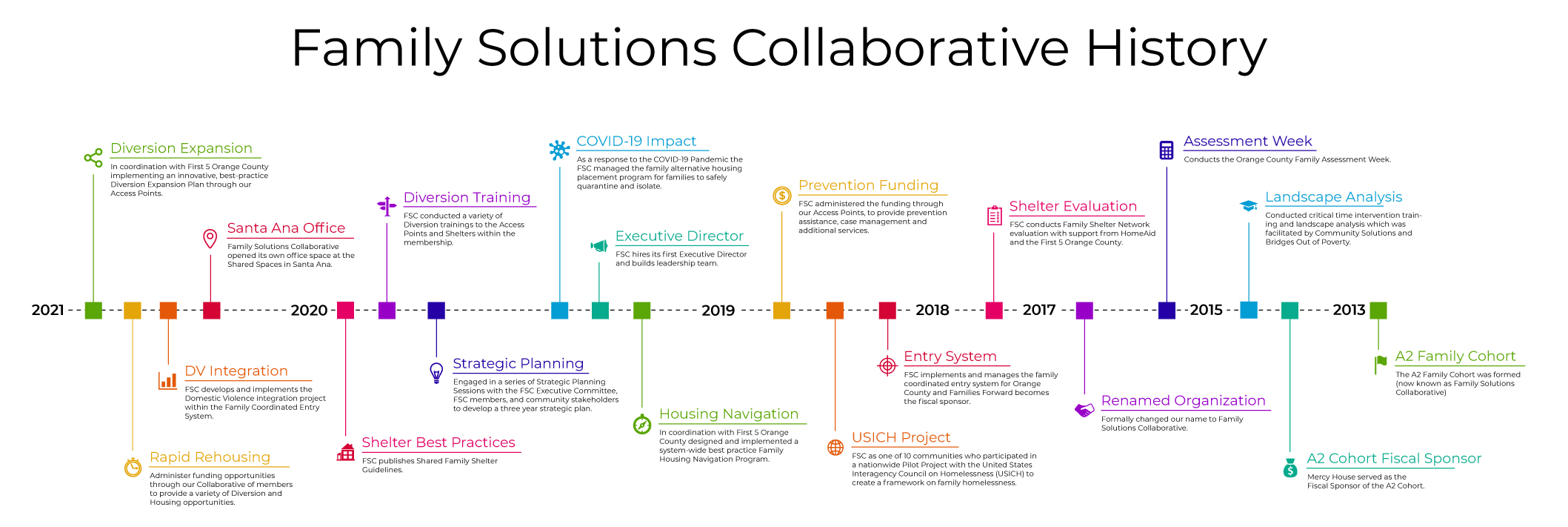In 2013, the A2 Family Cohort (now known as Family Solutions Collaborative) came together as a few local agencies as a grassroots effort to end family homelessness. At that time, the mission of the A2 Family Cohort was to develop a group of geographically diverse, homeless service providers to analyze the efficacy of current resources for homeless families and inform systemic changes that will end homelessness for children and families in Orange County. The agencies involved were Mercy Housing Living Centers, American Family Housing, Families Forward, Family Assistance Ministries, Pathways of Hope, and South County Outreach.
History & Success

In 2015, the A2 Family Cohort received a Learning Grant from the Orange County Community Foundation. This provided training for Critical Time Intervention which was facilitated by Community Solutions and Bridges Out of Poverty.
In Fiscal Year 2015-2016, the A2 Family Cohort received funding from First 5 of Orange County to conduct a series of Collective Impact trainings with the Executive and Director level staff of the A2 Family Cohort agencies. With the funding, the A2 Family Cohort was able to hire a consultant to conduct a Landscape Analysis and develop Theory of Change model. At that time, Mercy House was the lead agency for the A2 Family Cohort and served as the fiscal backbone organization.
In March of 2017, the A2 Family Cohort conducted the first ever Orange County Family Assessment Week. This was a focused effort to reach the community’s homeless families through the combined efforts of the County of Orange, 2-1-1 OC, the A2 Family Cohort with support from the First 5 Orange County. Ten agencies partnered together to conduct a homeless family count. In, 2021, the Family Solutions was invited to sit on the Orange County’s Point in Time Task Force, to represent the family sector. However, due to the Pandemic, the Point in Time Unsheltered Count was canceled by most communities nationwide out of an abundance of caution for unsheltered individuals and families. e County plans to resume the Point in Time County in January of 2022.
In November of 2017, the A2 Family Cohort contracted with the County of Orange’s Continuum of Care to implement and manage the Family Coordinated Entry. The Family Coordinated Entry System (FCES) is the “virtual front door” into the FCES to ensure fair and equitable access so that services can be provided in a timely and coordinated effort for shelterless families. Also at this time, the A2 Family Cohort changed the name to the Family Solutions Collaborative and Families Forward became the fiscal backbone.
In December of 2017, the Family Solutions Collaborative began the process of engaging in family shelter evaluation conversations with HomeAid of Orange County. HomeAid of Orange County held the responsibility for the evaluation of the efficiency of the shelters built or remodeled with First 5 Orange County funding.
In March of 2018, the Family Solutions Collaborative coordinated with Katherine Gale Consulting to conduct an FSC Family Shelter Network evaluation. This evaluation, commissioned by HomeAid Orange County and the Family Solutions Collaborative, with support from the First 5 Orange County, was intended to investigate and describe the process and of a coordination of effort to impact the family shelter system. The evaluation included the creation of five new, year-round shelters for families, and the launch of a coordinated systems approach.
In 2019, the Family Solutions Collaborative was one of 10 communities who participated in the United States Interagency Council on Homelessness (USICH) to create a framework on family homelessness. As one of the 10 nationwide communities, the FSC participated in a Pilot project to develop criteria and benchmarks for achieving the goal of ending family homelessness.
Also in 2019, the FSC received funding through the Orange County Continuum of Care for the Homeless Emergency Assistance Program, where the FSC administered the funding through our Access Points, to provide prevention assistance funding, case management and additional services.
In early 2020, the Family Solutions Collaborative applied for, and received funding through the First 5 Orange County to design a Family Housing Navigation Program and approach informed by State and local best-practices. The goal of the Project is to reduce family homelessness, reduce the length of stay in shelter and improve and expand on the system of homeless prevention. Also, as part of the funding, the development of a Diversion Expansion Plan, as outlined in this document.
As a response to the Pandemic, in 2020, the FSC received funding through the County of Orange Office of Care Coordination and the Orange County Department of Public Health to implement and manage the Alternative Shelter Placement Program. This program hired a full-time Family Response Specialist as well as funding to provide motel stays for literally homeless families who were affected by COVID. First 5 Orange County and the Department of Public Health provided additional funding for motel stays for families who were affected by COVID as well.
In 2020, the FSC received funding through a variety of sources, including St. Joseph / Providence to conduct a series of Strategic Planning Sessions with the FSC Executive Committee. These sessions and follow-up work is expected to be completed the summer of 2021. Also, the FSC received funding to support the operations and administrative costs of the FSC through a variety of partners and funders: Orange County Community Foundation, Be Well OC, Kaiser Hospital and Hoag Hospital.
In March of 2021, the FSC received funding through Orange County Office of Care Coordination to be the grant administrator of funding for Rapid Rehousing services, o flow through four of our member agencies, as a direct response to the Pandemic. This is a one-time funding opportunity that will allow our members an opportunity to assist over 200 literally homeless families with their housing needs with Rapid Rehousing Funding. The expected start date of this $4 Million opportunity is mid-April 2021 and will end June 30, 2022.
In April of 2021, the FSC extended and expanded the Homeless Emergency Assistance Program with the Orange County Office of Care Coordination for family homeless Prevention services, with funding to administer through our Access Points, with a projected start date of July 1, 2021 ending June 30, 2022.
In April of 2021, the FSC obtained our own office space at The Village at 17th Street.
In July of 2021, the FSC launched the Diversion Expansion Project, working on a systems-wide level to enhance Diversion/Problem Solving, best-practices within the family system. This effort is supported by First 5 of Orange County.
Also in July of 2021, the FSC received funding through Hoag Community Foundation, to develop and implement specialized training opportunities to our member agencies to increase knowledge, capacity and best-practices related to family homelessness.
In October of 2021, the FSC finalized our three-year strategic plan, identifying our four key areas:
The FSC Leads Orange County to End Family Homelessness: Through strong partnerships, our member organizations ideate, implement and advocate for innovations throughout the system, making the FSC the primary driver towards ending a family’s housing crisis quickly, utilizing prevention, diversion, and housing strategies.
The FSC is the Model in Orange County and Beyond: The FSC’s philosophy, systems and strategies for education, technical assistance, training, and tools are the models for ending family homelessness being replicated in other communities.
The Value and Impact of the FSC is Evident: It is clear and broadly acknowledged that the outcomes in solving the crisis of family homelessness and achieving housing justice are being accomplished through the advocacy and support of the FSC and our member organizations.
A Solid Funding Model Increases and Sustains Impact: The FSC’s diversified revenue is sufficient to sustain impact, seed innovations to meet emerging needs and attract additional federal, state, local and private dollars to Orange County.









